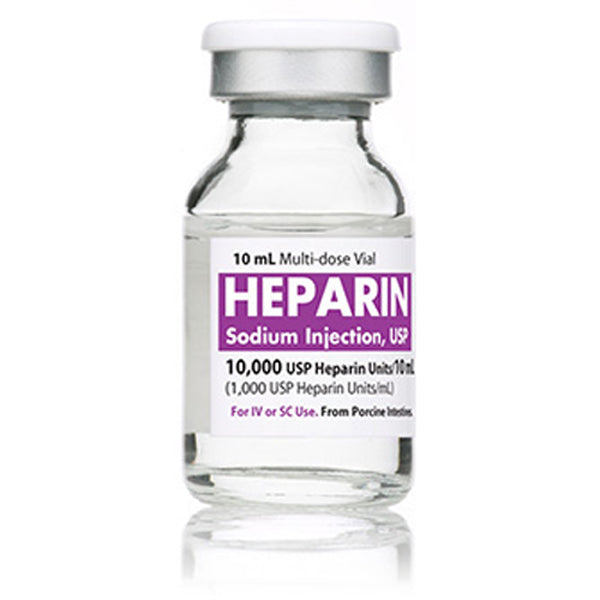Heparin Sodium Injection 10,000 USP Multiple-Dose Glass Fliptop Vials 10 mL x 25/Pack (RX)
(Note: We don’t Fill Personal Prescriptions)
How to Order:
You will receive instructions on how to create an account along with Rx Ordering Details.
Heparin Sodium Injection 10,000 USP is an anticoagulant used to prevent and treat blood clots in conditions such as deep vein thrombosis (DVT), pulmonary embolism, and atrial fibrillation. It is also used to maintain open intravenous lines and during surgical procedures to prevent thrombosis. Heparin works by inhibiting the formation of fibrin, a key protein in the blood clotting process, thus reducing the risk of clot-related complications.
Heparin Sodium Injection is an anticoagulant used to prevent and treat blood clots. It is commonly employed in medical settings to treat conditions such as deep vein thrombosis (DVT), pulmonary embolism, and to prevent clot formation in patients undergoing certain medical procedures or with clotting disorders. This formulation of Heparin Sodium is supplied by Pfizer Injectables, offered in 10 mL multiple-dose glass fliptop vials, typically packaged in 25 vials per pack.
Details and Features
Active Ingredient: Heparin Sodium
Concentration: 10,000 USP units per mL
Volume: 10 mL per vial
Packaging: 25 multiple-dose vials per pack
Formulation: Sterile solution for injection
Administration: Intravenous (IV) or subcutaneous injection
Manufacturer: Pfizer Injectables
Mechanism of Action
Heparin acts as an anticoagulant by enhancing the activity of antithrombin III, a protein that inhibits thrombin and other enzymes involved in the blood clotting process (such as factor Xa). By accelerating antithrombin III’s ability to deactivate thrombin, heparin prevents the conversion of fibrinogen to fibrin, effectively stopping clot formation and facilitating the dissolution of existing clots.
Warnings
-
Bleeding Risk: Heparin increases the risk of bleeding. It should be used with caution in patients with bleeding disorders, uncontrolled hypertension, or peptic ulcer disease.
-
Monitoring Required: Regular monitoring of activated partial thromboplastin time (aPTT) is necessary to ensure therapeutic levels and reduce bleeding risk.
-
Heparin-Induced Thrombocytopenia (HIT): A serious immune-mediated reaction; discontinue use and seek alternative anticoagulation if HIT is suspected.
-
Pregnancy: Use cautiously and only if clearly needed, as heparin does not cross the placenta and is generally considered safe, though the benefit-risk must be evaluated.
- Anemia and Osteoporosis: Long-term use can lead to decreased hematocrit levels and decreased bone density.
Side Effects
Common Side Effects:
- Local irritation at the injection site
- Mild pain or swelling around the injection area
Serious Side Effects:
-
Severe bleeding complications, including intracranial or gastrointestinal hemorrhage
-
Heparin-induced thrombocytopenia (HIT), characterized by a significant drop in platelet count
-
Allergic reactions, with symptoms such as rash, itching, or anaphylaxis
Osteoporosis with prolonged use
Administration and Monitoring
Heparin must be administered by healthcare professionals familiar with anticoagulation therapy. Careful patient monitoring is essential to balance the risk of thrombosis versus bleeding, including regular blood tests to adjust dosing. Emergency protocols should be in place to manage excessive anticoagulation or potential adverse effects. Utilizing nomograms for dosing and close observation in at-risk populations ensures effective and safe use of this anticoagulant in medical practice.

